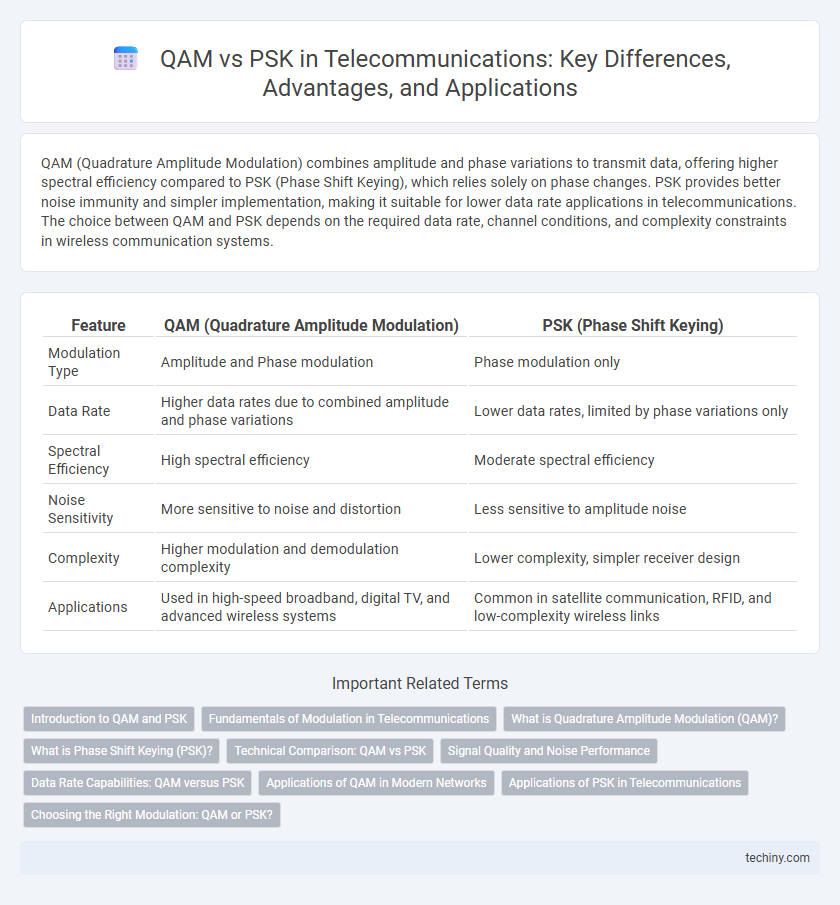QAM (Quadrature Amplitude Modulation) combines amplitude and phase variations to transmit data, offering higher spectral efficiency compared to PSK (Phase Shift Keying), which relies solely on phase changes. PSK provides better noise immunity and simpler implementation, making it suitable for lower data rate applications in telecommunications. The choice between QAM and PSK depends on the required data rate, channel conditions, and complexity constraints in wireless communication systems.
Table of Comparison
| Feature | QAM (Quadrature Amplitude Modulation) | PSK (Phase Shift Keying) |
|---|---|---|
| Modulation Type | Amplitude and Phase modulation | Phase modulation only |
| Data Rate | Higher data rates due to combined amplitude and phase variations | Lower data rates, limited by phase variations only |
| Spectral Efficiency | High spectral efficiency | Moderate spectral efficiency |
| Noise Sensitivity | More sensitive to noise and distortion | Less sensitive to amplitude noise |
| Complexity | Higher modulation and demodulation complexity | Lower complexity, simpler receiver design |
| Applications | Used in high-speed broadband, digital TV, and advanced wireless systems | Common in satellite communication, RFID, and low-complexity wireless links |
Introduction to QAM and PSK
Quadrature Amplitude Modulation (QAM) combines amplitude and phase variations to encode data, offering higher spectral efficiency in telecommunications. Phase Shift Keying (PSK) modulates the phase of a carrier signal to represent information, providing robustness against amplitude noise. Both QAM and PSK are essential modulation schemes for optimizing bandwidth and signal integrity in digital communication systems.
Fundamentals of Modulation in Telecommunications
Quadrature Amplitude Modulation (QAM) combines amplitude and phase variations to increase data transmission efficiency by encoding multiple bits per symbol, making it highly suitable for high-capacity broadband communications. Phase Shift Keying (PSK) modulates the carrier phase to represent data, offering robustness in noisy conditions and simpler receiver design. Understanding the fundamental trade-offs between QAM's spectral efficiency and PSK's noise resilience is essential for optimizing modulation schemes in modern telecommunications networks.
What is Quadrature Amplitude Modulation (QAM)?
Quadrature Amplitude Modulation (QAM) is a modulation technique that combines amplitude and phase variations of a carrier signal to encode data efficiently. It transmits information by altering the amplitude of two sinusoidal carriers shifted by 90 degrees, enabling higher data rates within limited bandwidth. QAM is widely used in telecommunications systems such as digital cable TV, DSL, and wireless communication for its capacity to optimize signal quality and increase spectral efficiency compared to Phase Shift Keying (PSK).
What is Phase Shift Keying (PSK)?
Phase Shift Keying (PSK) is a digital modulation technique used in telecommunications where the phase of a carrier signal is varied to represent data symbols. PSK encodes information by shifting the phase among a finite number of discrete states, commonly in formats such as Binary PSK (BPSK) and Quadrature PSK (QPSK). This method offers robustness against noise and efficient bandwidth utilization, making it ideal for wireless and satellite communications.
Technical Comparison: QAM vs PSK
Quadrature Amplitude Modulation (QAM) transmits data by varying both amplitude and phase of the carrier signal, offering higher spectral efficiency compared to Phase Shift Keying (PSK), which modulates data through phase changes alone. QAM's ability to combine amplitude and phase variations enables it to encode multiple bits per symbol, resulting in greater data throughput, whereas PSK generally provides better noise immunity and is simpler to implement. Trade-offs between QAM and PSK include QAM's increased sensitivity to amplitude noise and nonlinearities versus PSK's robustness in low signal-to-noise ratio environments and simpler receiver design.
Signal Quality and Noise Performance
Quadrature Amplitude Modulation (QAM) offers higher data rates by combining amplitude and phase modulation but is more susceptible to noise and signal distortion, affecting signal quality under poor channel conditions. Phase Shift Keying (PSK), particularly BPSK and QPSK, provides superior noise performance and better resilience to signal degradation due to its constant amplitude and phase variations, making it ideal for environments with low signal-to-noise ratios. Signal quality in QAM generally deteriorates faster than PSK as noise increases, requiring more complex error correction and equalization techniques to maintain reliable communication.
Data Rate Capabilities: QAM versus PSK
QAM (Quadrature Amplitude Modulation) supports higher data rates compared to PSK (Phase Shift Keying) due to its combined modulation of amplitude and phase, allowing the transmission of multiple bits per symbol. PSK primarily varies the phase of the carrier signal, which limits its bits-per-symbol capacity and results in lower spectral efficiency. Consequently, QAM is favored in modern telecommunications systems striving for increased throughput and bandwidth efficiency.
Applications of QAM in Modern Networks
Quadrature Amplitude Modulation (QAM) is extensively used in modern telecommunications networks for its ability to efficiently transmit large volumes of data over limited bandwidth, making it ideal for high-speed internet and digital television. QAM is preferred in advanced wireless communication systems such as 4G LTE and 5G due to its higher spectral efficiency compared to Phase Shift Keying (PSK), enabling enhanced data rates and improved signal quality. Optical fiber networks and cable modems also rely on QAM to support broadband services with robust performance under diverse channel conditions.
Applications of PSK in Telecommunications
Phase Shift Keying (PSK) is widely used in telecommunications for its robustness in noisy environments, making it ideal for satellite and wireless communication systems. Digital modulation schemes like BPSK, QPSK, and 8-PSK enable efficient data transmission in cellular networks, Wi-Fi, and RFID technologies. PSK's spectral efficiency and resistance to phase noise are critical for maintaining reliable connections in mobile and broadband services.
Choosing the Right Modulation: QAM or PSK?
QAM (Quadrature Amplitude Modulation) offers higher spectral efficiency by combining amplitude and phase variations, making it ideal for high data rate transmissions in bandwidth-constrained environments. PSK (Phase Shift Keying) provides better noise immunity and simpler implementation, suited for scenarios where signal robustness is critical. Selecting between QAM and PSK depends on the trade-off between required data throughput and channel conditions, with QAM favored for high capacity and PSK preferred for resilience in noisy channels.
QAM vs PSK Infographic

 techiny.com
techiny.com